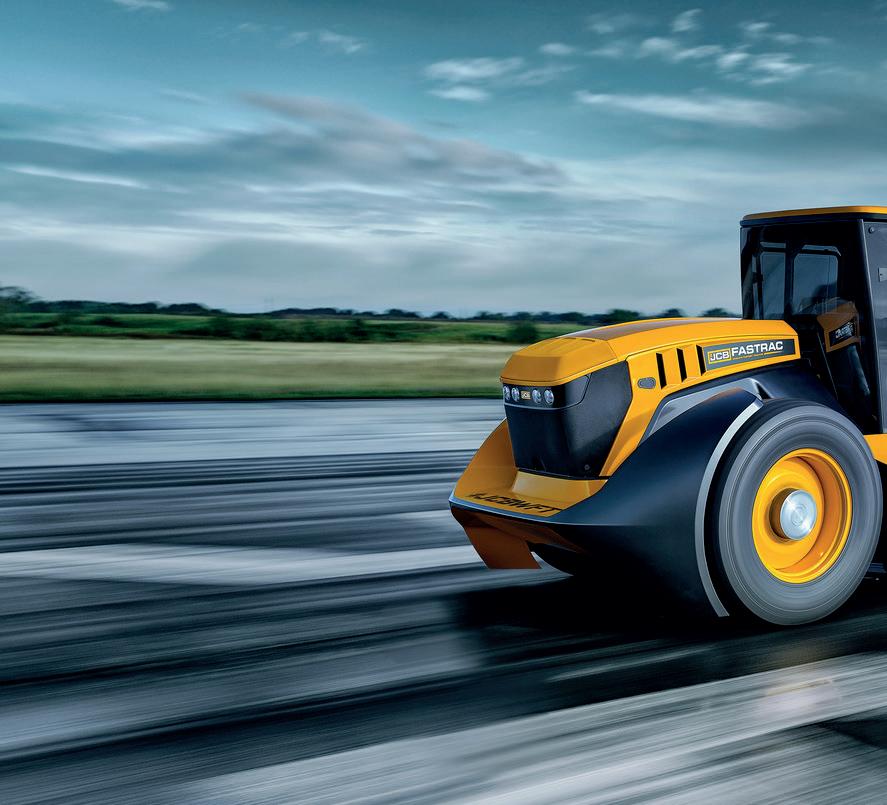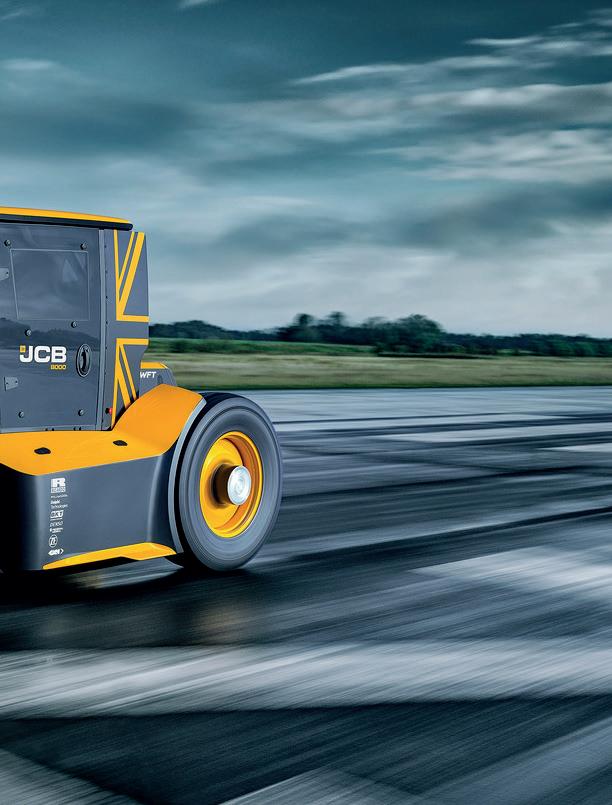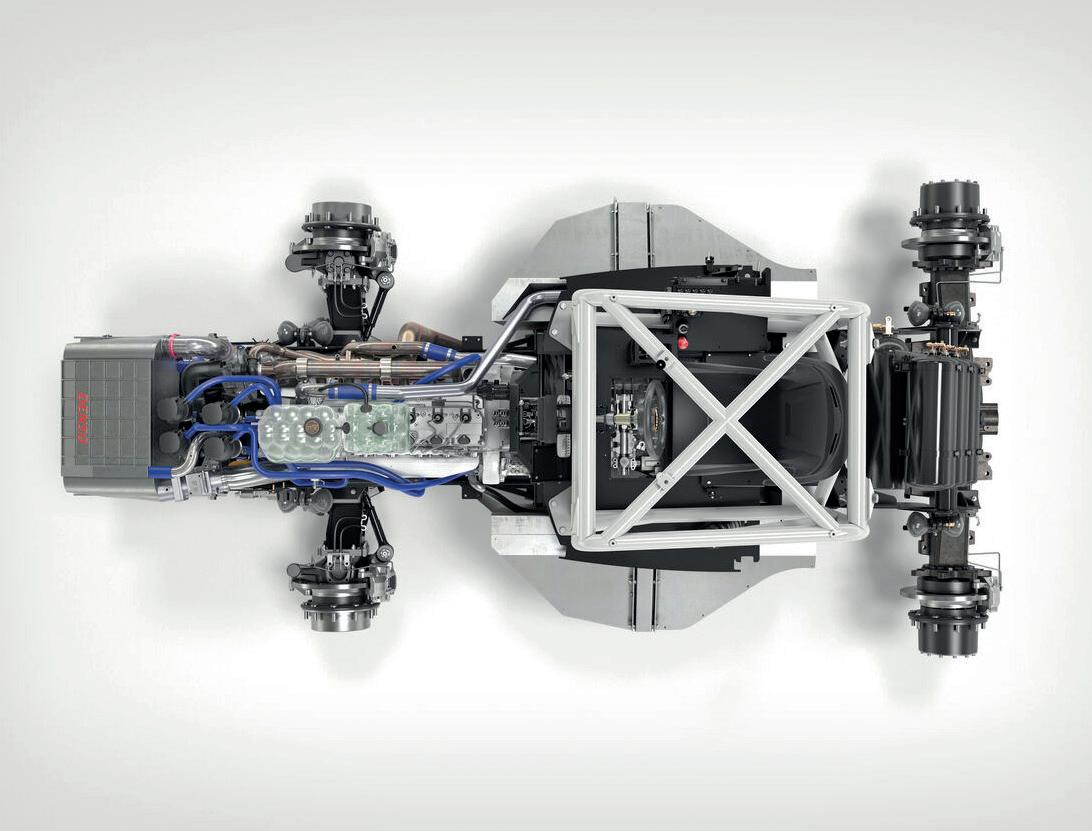
7 minute read
ENGINEERING THE WORLD’S FASTEST TRACTOR

The JCB Fastrac 2 achieved a top speed of 247.47 km/h
A young team of designers and engineers at JCB managed to set a new Guinness World Record for a modified tractor, called Fastrac 2, driven by none other than motorcycle racer Guy Martin. Will Dalrymple reports
JCB MARKETS A BRAND of fast tractors called Fastrac that can travel at speeds of up to 70 km/h. While at that speed even a large field will whip by, it still wasn’t fast enough for JCB Chairman Lord Bamford HonFIED, who had always wanted to attempt a world record, according to project manager Alex Skittery. (In fact, modified JCB engines were used in the fastest diesel-powered land vehicle, Dieselmax, which achieved speeds of more than 563 km/h in 2006.) But further impetus came from TV show Top Gear, whose jerryrigged tractor-truck reached a speed of 145 km/h on an episode aired in 2019. Skittery adds: ‘We saw their attempt and thought that we could probably do better than that.’
There were two ground rules. First, the primacy of operational safety – safeguarding the driver during the attempt and engineers during testing. Second was making sure that it didn’t transform into something unrecognisable as a tractor. Part of that was maximising the number of standard components; more than half of the parts used on the test vehicle were standard tractor or excavator parts.
The record attempt required two passes in opposite directions along a long, flat runway. The top speed would be taken as the average over the middle kilometre. The longest track the team could find was at the Elvington Airfield in York.
From that, the team ran multiple simulations to generate starting targets of vehicle weight, power, drag and gear ratios. That work suggested reducing weight from 8.5 tonnes to five tonnes to ease acceleration, improve the aerodynamics and increase engine output to more than 1,000 horsepower (the standard diesel engine produces 240 horsepower).
Chassis weight was reduced by removing every non-essential structural part – such as the tow hitch – and then running the design through topology-optimisation software and finite element analysis. The ‘weird and wonderful’ shapes output were reinterpreted in sheet steel for buildability and then that model was optimised again.
UNFAMILIAR GROUND
Aerodynamic drag isn’t significant for most tractors; the main resistive element at standard operating speeds is rolling resistance. But of course, this wouldn’t be a typical situation. The team turned to motor racing group Williams Advanced Engineering, which applied computational fluid dynamics techniques, which Skittery described as a virtual wind tunnel, to understand how the machine was disrupting airflow.
To help the JCB team better understand the results, Williams and JCB developed an immersive virtual reality 3D model of the airflow that included airstream bars that were colour-coded to indicate their effect on drag.
As a result of this work, the team

reduced the frontal area, making the cab 400 millimetres lower, 300 millimetres narrower, and adding a front splitter – a kind of pointy front bumper – changed the roof design, added fins to the rear of the roof and made other tweaks.
Of the driveline, one of the most difficult areas was the tyres, which had to be safe and stable at 240 km/h. Collaboration with supplier BKT Tires involved modifying a standard tractor tyre shape by adding more natural rubber for better grip and by adding two steel belts to stop the tyre deforming at such high speeds. Test rig measurements found that it gained 20 millimetres of diameter at 240 km/h. The team also shaved the treads in order to reduce outer edge forces and movement due to tyre hysteresis (flexing).
At a rig in Germany that normally tests aeroplane tyres, the team simulated the record run and also tested the tyres in even more extreme duty. Skittery picks up the story: ‘We did find that limit, as well as the failure mode. In fact, before failure, the tyre started to vibrate excessively before it went bang, so we could instrument that on the machine. We had live vibration, temperature and air pressure monitoring, so if anything got to the ceiling limits, it would tell the driver.’
Axles used were standard, but altered; centre differentials were locked up to prevent excessive wheelspin off the line.
Moving up the crankshaft, a sixspeed manual transmission was chosen for weight and simplicity. Although the driver would only get to fifth gear in the run (a 1:1 ratio, incidentally), there the box offered 99 per cent-plus mechanical efficiency.
Switching between gears was a heavy-duty eight-plate wet tractor clutch that, ironically, offered the heavy duty required, although in a completely different operational context. ‘This duty is asking a lot; it has to handle a really high torque capacity and we need to slip it to get it going from standstill,’ says the project manager.
Last but probably most was the engine; not from a tractor but a standard JCB 672 7.2-litre diesel. Block, head, pistons, crankshaft, rockers, rocker shafts, water pump, oil pump and fuel lines was all standard. (Actually the pistons were specially machined to have an open bowl design to reduce the compression ratio.)
To quadruple the power output, the team modified the engine to, simply put, squirt in more fuel and blow in more air. A larger fuel pump and larger injectors provided 2.7 litres of red diesel per minute at 2,500 bar. On

A parachute was added to the tractor for safety reasons but wasn’t needed
a test run, that reduced the tractor’s fuel efficiency by seven times.
Three modifications provided the extra air. First was a larger turbocharger, offering a five bar boost pressure of 1,000 litres per second once the engine was running quickly, but at slow speeds it suffered from turbo lag. To reduce that, a Federal Mogul COBRA electronic supercharger was fitted; running at 24V and powered by lithium-ion rechargeable batteries, this could spin up from standstill to 50,000 rpm in less than a second and fed air into the turbocharger at engine revs below 2,000 rpm. Pressure sensors worked out when the turbo was breathing more air than the supercharger and switched it off.
As that didn’t remove all of the lag, the team added another system on top: an air pulse system that injects 20 bar of air into the exhaust manifold from a scuba compressed-air tank mounted on the back of the vehicle. This provided a five-second boost when setting off from the line and during each gear change. Every run consumed an entire tank.
Of course, all of this fuel and air raised temperatures inside the engine. ‘There was a fine balance between hot and cold,’ Skittery says. The team devised various preheating strategies to keep the cylinders warm to reduce cylinder pressures when air is being pumped in. ‘At the same time, we wanted the air inlet to be nice and cold when it was running.’ Cooling systems included a water-charged air cooler that treated turbocharged air. As the water radiator didn’t carry sufficient heat capacity under those conditions, it was supplemented by a 60-litre water tank mounted at the front of the machine that was filled with 25 kilograms of ice, which melted in a single run. ‘We had quite a few trips to Tesco, clearing out its freezers to keep our stocks up.’
In addition, as there wasn’t enough space on the front of the vehicle for the oil and water radiators (where they would be in the standard tractor configuration), they were moved to the sides of the chassis, between the wheels, and cooled only by ram air.
‘It was a really important part of the design process of the bodywork to funnel and channel the air into those radiators. There was a lot of CFD analysis to optimise that.’ Water was also injected into the air intake and cold oil washed at the bottom of the cylinders.
Although much of the work on the project was one-off engineering, Skittery says that after the project, the entire team was moved on to develop the next generation of tractors. And he says that there are a number of transferable learnings. ‘A lot of this work was about optimising the machine: make it lighter, the tyres more efficient and reduce rolling resistance. A lot of that will be carried forward to the next generation. Fuel isn’t getting cheaper; farms aren’t making more money. The price of wheat remains stagnant. So ways to maximise inputs into farming systems come down to machine design.’
Alan Tolley, former director, JCB engine programmes, reinforces that point. ‘From an engine point of view, the traditional view is that racing improves the breed. It does give a reference in terms of the capability of the base engine.’ ■

Fastrac 2 was based on a standard, commercially available Fastrac model
FURTHER INFORMATION
This article is based on a presentation given as the annual lecture of the Institution of Mechanical Engineers’ Powertrain Systems and Fuels Group. For more, visit www.is.gd/ihumel


